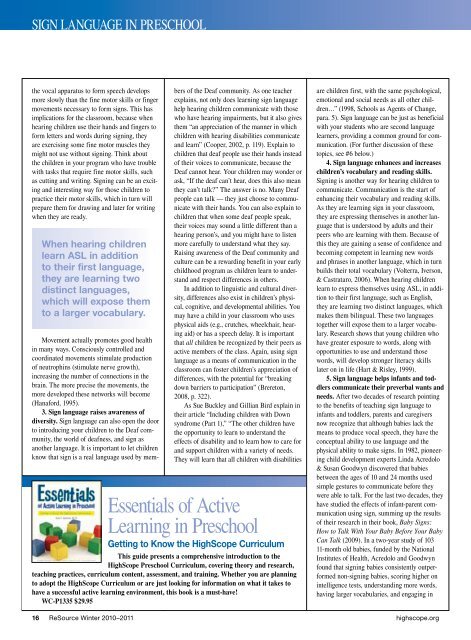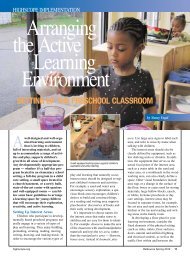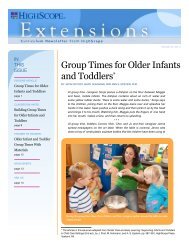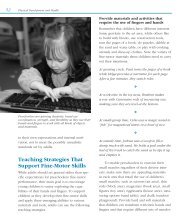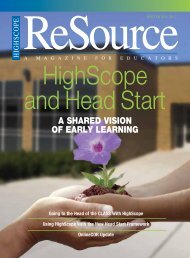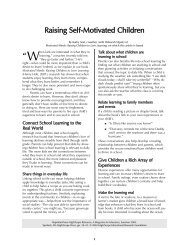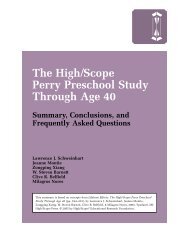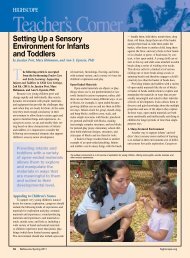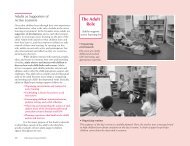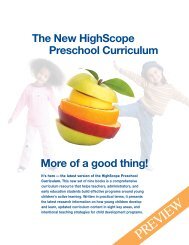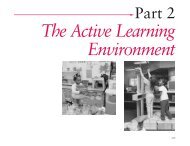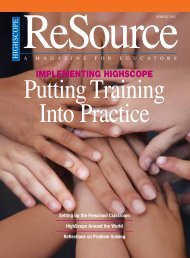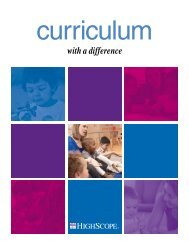DIVERSE AND INCLUSIVE CLASSROOM - High/Scope Educational ...
DIVERSE AND INCLUSIVE CLASSROOM - High/Scope Educational ...
DIVERSE AND INCLUSIVE CLASSROOM - High/Scope Educational ...
Create successful ePaper yourself
Turn your PDF publications into a flip-book with our unique Google optimized e-Paper software.
SIgn LAngUAgE In PRESCHOOL<br />
the vocal apparatus to form speech develops<br />
more slowly than the fine motor skills or finger<br />
movements necessary to form signs. This has<br />
implications for the classroom, because when<br />
hearing children use their hands and fingers to<br />
form letters and words during signing, they<br />
are exercising some fine motor muscles they<br />
might not use without signing. Think about<br />
the children in your program who have trouble<br />
with tasks that require fine motor skills, such<br />
as cutting and writing. Signing can be an exciting<br />
and interesting way for those children to<br />
practice their motor skills, which in turn will<br />
prepare them for drawing and later for writing<br />
when they are ready.<br />
When hearing children<br />
learn ASL in addition<br />
to their first language,<br />
they are learning two<br />
distinct languages,<br />
which will expose them<br />
to a larger vocabulary.<br />
movement actually promotes good health<br />
in many ways. Consciously controlled and<br />
coordinated movements stimulate production<br />
of neutrophins (stimulate nerve growth),<br />
increasing the number of connections in the<br />
brain. The more precise the movements, the<br />
more developed these networks will become<br />
(Hanaford, 1995).<br />
3. Sign language raises awareness of<br />
diversity. Sign language can also open the door<br />
to introducing your children to the Deaf community,<br />
the world of deafness, and sign as<br />
another language. It is important to let children<br />
know that sign is a real language used by mem-<br />
bers of the Deaf community. As one teacher<br />
explains, not only does learning sign language<br />
help hearing children communicate with those<br />
who have hearing impairments, but it also gives<br />
them “an appreciation of the manner in which<br />
children with hearing disabilities communicate<br />
and learn” (Cooper, 2002, p. 119). Explain to<br />
children that deaf people use their hands instead<br />
of their voices to communicate, because the<br />
Deaf cannot hear. Your children may wonder or<br />
ask, “If the deaf can’t hear, does this also mean<br />
they can’t talk?” The answer is no. many Deaf<br />
people can talk — they just choose to communicate<br />
with their hands. You can also explain to<br />
children that when some deaf people speak,<br />
their voices may sound a little different than a<br />
hearing person’s, and you might have to listen<br />
more carefully to understand what they say.<br />
Raising awareness of the Deaf community and<br />
culture can be a rewarding benefit in your early<br />
childhood program as children learn to understand<br />
and respect differences in others.<br />
In addition to linguistic and cultural diversity,<br />
differences also exist in children’s physical,<br />
cognitive, and developmental abilities. You<br />
may have a child in your classroom who uses<br />
physical aids (e.g., crutches, wheelchair, hearing<br />
aid) or has a speech delay. It is important<br />
that all children be recognized by their peers as<br />
active members of the class. Again, using sign<br />
language as a means of communication in the<br />
classroom can foster children’s appreciation of<br />
differences, with the potential for “breaking<br />
down barriers to participation” (Brereton,<br />
2008, p. 322).<br />
As Sue Buckley and gillian Bird explain in<br />
their article “Including children with Down<br />
syndrome (Part 1),” “The other children have<br />
the opportunity to learn to understand the<br />
effects of disability and to learn how to care for<br />
and support children with a variety of needs.<br />
They will learn that all children with disabilities<br />
Essentials of Active<br />
Learning in Preschool<br />
Getting to Know the <strong>High</strong><strong>Scope</strong> Curriculum<br />
This guide presents a comprehensive introduction to the<br />
<strong>High</strong><strong>Scope</strong> Preschool Curriculum, covering theory and research,<br />
teaching practices, curriculum content, assessment, and training. Whether you are planning<br />
to adopt the <strong>High</strong><strong>Scope</strong> Curriculum or are just looking for information on what it takes to<br />
have a successful active learning environment, this book is a must-have!<br />
WC-P1335 $29.95<br />
are children first, with the same psychological,<br />
emotional and social needs as all other children…”<br />
(1998, Schools as Agents of Change,<br />
para. 5). Sign language can be just as beneficial<br />
with your students who are second language<br />
learners, providing a common ground for communication.<br />
(for further discussion of these<br />
topics, see #6 below.)<br />
4. Sign language enhances and increases<br />
children’s vocabulary and reading skills.<br />
Signing is another way for hearing children to<br />
communicate. Communication is the start of<br />
enhancing their vocabulary and reading skills.<br />
As they are learning sign in your classroom,<br />
they are expressing themselves in another language<br />
that is understood by adults and their<br />
peers who are learning with them. Because of<br />
this they are gaining a sense of confidence and<br />
becoming competent in learning new words<br />
and phrases in another language, which in turn<br />
builds their total vocabulary (volterra, Iverson,<br />
& Castrataro, 2006). When hearing children<br />
learn to express themselves using ASL, in addition<br />
to their first language, such as English,<br />
they are learning two distinct languages, which<br />
makes them bilingual. These two languages<br />
together will expose them to a larger vocabulary.<br />
Research shows that young children who<br />
have greater exposure to words, along with<br />
opportunities to use and understand those<br />
words, will develop stronger literacy skills<br />
later on in life (Hart & Risley, 1999).<br />
5. Sign language helps infants and toddlers<br />
communicate their preverbal wants and<br />
needs. After two decades of research pointing<br />
to the benefits of teaching sign language to<br />
infants and toddlers, parents and caregivers<br />
now recognize that although babies lack the<br />
means to produce vocal speech, they have the<br />
conceptual ability to use language and the<br />
physical ability to make signs. In 1982, pioneering<br />
child development experts Linda Acredolo<br />
& Susan goodwyn discovered that babies<br />
between the ages of 10 and 24 months used<br />
simple gestures to communicate before they<br />
were able to talk. for the last two decades, they<br />
have studied the effects of infant-parent communication<br />
using sign, summing up the results<br />
of their research in their book, Baby Signs:<br />
How to Talk With Your Baby Before Your Baby<br />
Can Talk (2009). In a two-year study of 103<br />
11-month old babies, funded by the national<br />
Institutes of Health, Acredolo and goodwyn<br />
found that signing babies consistently outperformed<br />
non-signing babies, scoring higher on<br />
intelligence tests, understanding more words,<br />
having larger vocabularies, and engaging in<br />
16 ReSource Winter 2010–2011 highscope.org


